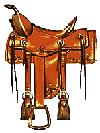|
Western Saddle Types -
|

|
- saddles for pleasure riding, and
- saddles for eventing, competition or work.
In the first category the focus is primarily on comfort in the second, it's performance.
We're not saying that if calf roping is the name of the game the rider shouldn't be comfortable, only that a roping saddle is designed with roping in mind.
And there are differences. A Cutting saddle will not be comfortable for longer rides and in competitive events the performance of horse and rider could suffer if a saddle designed for Trail Riding was used.
Let's take a look at a half dozen of the more popular styles and see which might be best for your purposes. It might be obvious or you might have a bit of a choice to make and want to research things a bit further.
But the following information will help you get to the next step.
Western Pleasure or Trail Riding
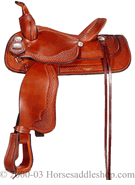 With emphasis on support and comfort rather than speed and action, the Trail Riding saddle is often lighter than the companion "working " saddles.
With emphasis on support and comfort rather than speed and action, the Trail Riding saddle is often lighter than the companion "working " saddles.
The cantle is higher than for most of the other western saddles and has a more pronounced dish. Likely the most popular of the western styles, the Trail Rider is used either with front cinch only or front and back cinch.
Shown here is a Crates Trail Saddle
The seat shape and rigging are generally such that the balance of the rider is towards the rear of the saddle for maximum comfort on longer rides.
The best style for someone who just wants to go "horseback riding". **********
Reining Saddle
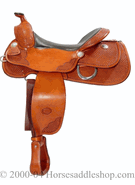 Another popular style-
Another popular style- the Reining saddle is characterized by a lower horn to minimize interference with the reins and hands.
The tree is shaped for close contact with the horse and the seat is shaped to give the rider a measure of security when making quick stops. Reining saddles generally have a front cinch only.
Shown here, a Classic Reiner by Billy Cook - Original
A more experienced rider may prefer the reining saddle to the trail riding style, especially if working with horses much of the time and in competition. **********
Cutting Saddle
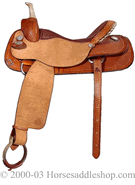 In cutting competition the rider must remain on board during sudden starts stops twists and turns of the horse.
In cutting competition the rider must remain on board during sudden starts stops twists and turns of the horse. This is accomodated by a flatter than normal seat which allows the rider to shift easily in response to the horse's actions. The low point of the saddle is a bit further forward than is the case with the pleasure saddle and the horn and swell are higher than for most other styles (for hangin' on). This allows the rider to remain on "top of the horse" in the midst of the action.
Shown here is a cutting saddle by Circle Y Saddles.
Obviously a saddle type for a very specific purpose. **********
Roping Saddle
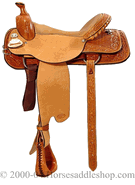 Here you need a strong horn and tree (as well as the rigging) to withstand the rigors of roping.
Here you need a strong horn and tree (as well as the rigging) to withstand the rigors of roping. The low fork and distinct horn (short and stocky) are designed to reduce pressure on the horse's withers and, together with a lower than normal cantle, gives the rider greater freedom of movement. Team roping saddles are often up to 10 pounds heavier than the other western saddles. Shown here, a Reinsman Working Cow Horse Saddle
As we will note in the discussion on saddle fit, the Trail Rider, or other eventing saddles should not be used for roping. Not only are they not durable enough but injury to the horse's withers could occur. When that rope goes tight it's like dropping a 100 pound sack of cement on a rope as far as the pressure on the horn and fork is concerned.The lower horn and fork keeps that pressure from being transmitted to the horse's withers as well as keeping the horn intact.
Some tie-down (calf) ropers prefer a seat slightly smaller in size than they would use in pleasure or trail riding, e.g., a 14' seat as opposed to a 16' or 17' seat. Since the roper is standing in the stirrups the smaller seat will offer slightly greater support. If Roping is the game, get a Roping Saddle and nothing else. **********
Barrel Racing
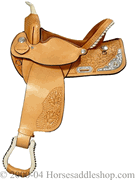 For barrel racing you want the comfort of the pleasure saddle combined with a need for rider stability and balance during tight turns.
For barrel racing you want the comfort of the pleasure saddle combined with a need for rider stability and balance during tight turns. The Barrel Racing saddle has a very deep seat and a high horn. The skirt is usually smaller in size and rounded in front so as not to interfere with the motion of the horse in the tight turns. The seat covering is often stressed or half-rough leather providing better gripping power.
Shown here, a Barrel Racing Saddle by DakotaTrees are often of synthetic material such as Ralide for a lighter saddle. The Barrel Racing Saddle generally has a front cinch only.
Because of the deep seat which offers a greater sense of security, some riders like to use a Barrel Racing Saddle on the Trail.
Quite all right.**********
Flexible Tree Saddles
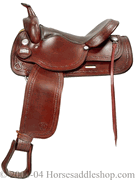 A relatively recent innovation, the flexible tree saddle is designed to provide an improved fit, accomodating the changing conformation of the horse in motion.
A relatively recent innovation, the flexible tree saddle is designed to provide an improved fit, accomodating the changing conformation of the horse in motion.
This has been achieved through the use of a combination of polyethylene plastic, leather and heat tempered spring steel.
Both the tree and the seat are flexible and the saddle is lighter with thinner bars, getting the rider closer to the horse.
Show here, a Big Horn Flex Tree FQHB Saddle
The flexible tree saddle is generally not strong enough for roping or a "working saddle" but is increasingly popular for pleasure riding. **********
- And finally, -
The Show Saddle
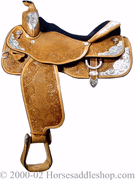 With the Show/Equitation Saddle, good fit to the horse and rider are every bit as important as for any other saddle, more so some would argue.
With the Show/Equitation Saddle, good fit to the horse and rider are every bit as important as for any other saddle, more so some would argue. The tree is designed to balance the rider in the center of the saddle while allowing close contact with the horse.
Shown here is a Circle Y TAOS Show Saddle and you can view a selection of mouth-watering show saddles by clicking here.
Show saddles are often custom made and for the most part a good deal more expensive than most other saddle types.
This is due in part to intricate hand carving and customizing, often with highly specialized motifs, and in part to inlays of silver or other material. The skirts are often larger than for other saddle types to better show the intricate customizing features.
The Saddle Horn Just a few words about a part of the saddle whose size an shape is of importance for certain saddle types and uses. That's been touched upon in the narrative above. But if you're a novice or a recreational rider, the rule of thumb for the optimum height and shape of the saddle horn is basically whatever you want it to be.
Most of us use the saddle horn as an aid in mounting and dismounting and something to hang on to when things get a little dicey. The horn is also a convenient for a pommel bag to carry small items like a camera or binoculars. Most of the time I don't pay much attention to the saddle horn but, like Linus' security blanket I would miss it if it wasn't there.

|
A Good Book About Saddles
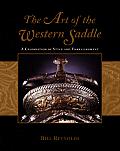
Now if someone is expecting a saddle as a gift, giving a book on saddles could be a mistake - to put it mildly. But for those who who have an interest in western saddles William Reynolds' The Art of the Western Saddle: A Celebration of Style & Embellishment would be a fine gift indeed.
This book, just recently published has received fine reviews. It's filled with detailed photographs and illustrations, and highlights the work of old-time makers such as Visalia Stock Saddle Company, Miles City Saddlery, and Edward H. Bohlin, along with many contemporary makers.


